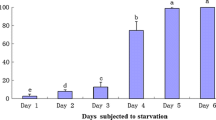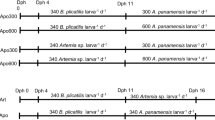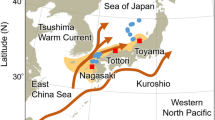Abstract
Aquaculture studies have revealed that polyunsaturated fatty acids are critical for maintaining substantial growth, survival and reproductive rates, and high food conversion efficiencies for a wide variety of marine and freshwater organisms. The aim of this study was to investigate the gross biochemical and fatty acid composition of both neutral and polar lipid compartments of the razor clam Solen marginatus throughout embryonic and larval development. High levels of stored reserves in S. marginatus eggs allow a short larval development, lasting only 8 days. The energy required for embryogenesis was obtained from stored proteins. During larval development from D-shaped veliger until settlement, protein, lipid, and carbohydrate reserves were indistinctly stored for metamorphosis. Although total lipids increased, fatty acids in both neutral and polar lipids decreased during embryonic development. The depots allow a short larval development in which settlement is reached with lower amounts of stored neutral and polar lipids than the contents found in the oocytes. Non-methylene-interrupted dienoic fatty acid levels were similar to those of some polyunsaturated fatty acids, with increasing percentages at the onset of metamorphosis. This study indicates that S. marginatus exhibits a different pattern in the use of gross biochemical and fatty acid reserves during larval development compared to other razor clam and bivalve species, mainly due to the large size of its eggs and the short larval development stage reported in this species.




Similar content being viewed by others
References
Ackman RG, Kean-Howie J (1995) Fatty acids in aquaculture: are n-3 fatty acids always important? In: Lim C, Sessa DJ (eds) Nutrition and utilization technology in aquaculture. AOCS Press, Champaign, pp 82–104
Baker SM, Mann R (1994) Feeding ability during settlement and metamorphosis in the oyster Crassostrea virginica (Gmelin, 1791) and the effects of hypoxia on postsettlement ingestion rates. J Exp Mar Biol Ecol 181:239–253
Barlett BR (1979) Biochemical changes in the Pacific oyster, Crassostrea gigas (Thunberg) during larval development and metamorphosis. Proc Natl Shellfish Assoc 202
Bensadoun A, Weinstein D (1976) Assay of proteins in the presence of interfering material. Anal Biochem 70:241–250
BIM (2005) European market for razor clams (Ensis ensis and Ensis siliqua). Irish Sea Fisheries Board. BIM Market Development Division, Dublin
Bligh EG, Dyer WJ (1959) A rapid method of total lipid extraction and purification. Can J Biochem Physiol 37:911–917
Brett JR, Groves TDD (1979) Physiological energetics. In: Hoar WS, Randall DJ, Brett JR (eds) Fish physiology, vol 8. Academic Press, New York, pp 280–352
Brown MR, Jeffrey SW, Volkman JK, Dunstan GA (1997) Nutritional properties of microalgae for mariculture. Aquaculture 151:315–331
da Costa F (2009) Optimización del cultivo en criadero de navaja (Ensis arcuatus Jeffreys, 1865), longueirón (E. siliqua Linneo, 1758) y longueirón vello (Solen marginatus Pennánt, 1777): composición bioquímica y de ácidos grasos en los desarrollos larvarios. PhD Dissertation, University of Santiago de Compostela, 336 pp
da Costa F, Martinez-Patiño D (2009) Culture potential of the razor clam Solen marginatus (Pennant, 1777). Aquaculture 288:57–64. doi:10.1016/j.aquaculture.2008.11.001
Delaporte M, Soudant P, Moal J, Kraffe E, Marty Y, Samain JF (2005) Incorporation and modification of dietary fatty acids in gill polar lipids by two bivalve species Crassostrea gigas and Ruditapes philippinarum. Comp Biochem Physiol Part A 140:460–470
Delaunay F, Marty Y, Moal J, Samain JF (1992) Growth and lipid class composition of Pecten maximus (L.) larvae grown under hatchery conditions. J Exp Mar Biol Ecol 163:209–219
Delaunay F, Marty Y, Moal J, Samain JF (1993) The effect of monospecific algal diets on growth and fatty acid composition of Pecten maximus (L.) larvae. J Exp Mar Biol Ecol 173:163–179
Falkner I, Byrne M, Sewell MA (2006) Maternal Provisioning in Ophionereis fasciata and O. schayeri: Brittle stars with contrasting modes of development. Biol Bull 211:204–207
Farías A, Uriarte I, Castilla JC (1998) A biochemical study of the larval and postlarval stages of the Chilean scallop Argopecten purpuratus. Aquaculture 166:37–47
Farías A, Bell JG, Uriarte I, Sargent JR (2003) Polyunsaturated fatty acids in total lipid and phospholipids of Chilean scallop Argopecten purpuratus (L.) larvae: effects of diet and temperature. Aquaculture 228:289–305
Fraga F (1956) Determinación de glucógeno en moluscos con el reactivo de la antrona. Inv Pesq 3:69–74
Fraser AJ, Gamble JC, Sargent JR (1988) Changes in lipid content, lipid class composition and fatty acid composition of developing eggs and unfed larvae of cod (Gadus morhua). Mar Biol 99:307–313
Gallager SM, Mann R, Sasaki GC (1986) Lipid as an index of growth and viability in three species of bivalve larvae. Aquaculture 56:81–103
Haws MC, DiMichele L, Hand SC (1993) Biochemical changes and mortality during metamorphosis of the Eastern Oyster, Crassostrea virginica, and the Pacific oyster, Crassostrea gigas. Mol Mar Biol Biotechnol 2:207–217
Helm MM, Bourne N (2004) Hatchery operation: Broodstock conditioning, spawning and fertilization. In: Lovatelli A (ed) Hatchery culture of bivalves. A practical manual. FAO Fish. Tech. Paper, Rome, pp 59–83
Helm MM, Laing I (1987) Preliminary observations on the nutritional value of “Tahiti Isochrysis” to bivalve larvae. Aquaculture 62:281–288
Helm MM, Holland DL, Stephenson RR (1973) The effect of supplementary algal feeding of a hatchery and breeding stock of Ostrea edulis L. on larval vigour. J Mar Biol Assoc UK 53:673–684
Henderson RJ, Bell MV, Sargent JR (1985) The conversion of polyunsaturated fatty acids to prostaglandins by tissue homogenates of the turbot, Scophthalmus maximus (L.). J Exp Mar Biol Ecol 85:93–99
Hess HH, Lees JE, Derr JE (1978) A linear Lowry-Folin assay for both water-soluble and sodium dodecyl sulfate-solubilized proteins. Anal Biochem 85:259–300
Holland DL (1978) Lipid reserves and energy metabolism in the larvae of benthic marine invertebrates. In: Malius DC, Sargent JR (eds) Biochemical and biophysical perspectives in marine biology, vol 4. Academic Press, London, pp 85–123
Holland DL, Spencer BE (1973) Biochemical changes in fed and starved oysters, Ostrea edulis (L.) during larval development, metamorphosis and early spat growth. J Mar Biol Assoc UK 53:287–298
Jonsson PR, Berntsson KM, André C, Wängberg S-A (1999) Larval growth and settlement of the European oyster (Ostrea edulis) as a function of food quality measured as fatty acid composition. Mar Biol 134:559–570
Klingensmith J (1982) Distribution of methylene and nonmethylene-interrupted dienoic fatty acids in polar lipids and triacylglycerols of selected tissues of the hardshell clam (Mercenaria mercenaria). Lipids 17:976–981
Kraffe E, Soudant P, Marty Y (2004) Fatty acids of serine, ethanolamine, and choline plasmalogens in some marine bivalves. Lipids 39:59–66
Labarta U, Fernandez-Reiriz M, Perez-Camacho A (1999) Dynamics of fatty acids in the larval development, metamorphosis and post-metamorphosis of Ostrea edulis (L.). Comp Biochem Physiol Part A 123:249–254
Langdon CJ, Waldock MJ (1981) The effect of algal and artificial diets on the growth and fatty acid composition of Crassostrea gigas spat. J Mar Biol Assoc UK 61:431–448
Liu H, Kelly MS, Cook EJ, Black K, Orr H, Zhu JX, Dong SL (2007) The effect of diet type on growth and fatty-acid composition of sea urchin larvae, I. Paracentrotus lividus (Lamarck, 1816) (Echinodermata). Aquaculture 264: 247–262
Lowry OH, Rosebrough NJ, Farr AL, Randall RJ (1951) Protein measurement with the Folin phenol reagent. J Biol Chem 193:265–275
Marsh JB, Weinstein DB (1966) Simple charring method for determination of lipids. J Lipid Res 7:574–576
Marshall DJ, Keough MJ (2006) Complex life cycles and offspring provisioning in marine invertebrates. Integr Comp Biol 46:643–651
Marty Y, Delaunay F, Moal J, Samain JF (1992) Changes in the fatty acid composition of Pecten maximus (L.) during larval development. J Exp Mar Biol Ecol 163:221–234
Metcalfe LD, Schmitz AA (1961) The rapid preparation of fatty acid esters for gas chromatography analysis. Anal Chem 33:363–364
Nóvoa S (2007) Metabolismo lipídico, ácidos grasos en el cultivo larvario de almeja babosa, Venerupis pullastra (Montagu, 1803). Calidad ovocitaria, larvaria y nutricional con una aproximación al uso de la microencapsulación lipídica. PhD Dissertation. University of Santiago de Compostela, 244 pp
Paradis M, Ackman R (1977) Potential for employing the distribution of anomalous non-methylene-interrupted dienoic fatty acids in several marine invertebrates as part of food web studies. Lipids 12:170–176
Pernet F, Tremblay R, Bourget E (2003) Biochemical indicator of sea scallop (Placopecten magellanicua) quality based on lipid class composition: Part I: Broodstock conditioning and young larval performance. J Shellfish Res 22:365–375
Pernet F, Bricelj VM, Parrish CC (2005) Effect of varying dietary levels of omega 6 polyunsaturated fatty acids during the early ontogeny of the sea scallop, Placopecten magellanicus. J Exp Mar Biol Ecol 327:115–133
Pernet F, Bricelj VM, Cartier S (2006) Lipid class dynamics during larval ontogeny of the sea scallops, Placopecten magellanicus, in relation to metamorphic success and response to antibiotics. J Exp Mar Biol Ecol 329:265–280
Pirini M, Manuzzi MP, Pagliarani A, Trombetti F, Borgatti AR, Ventrella V (2007) Changes in fatty acid composition of Mytilus galloprovincialis (Lmk) fed on microalgal and wheat germ diets. Comp Biochem Physiol Part B 147:616–626
Prowse T, Sewell M, Byrne M (2008) Fuels for development: evolution of maternal provisioning in asterinid sea stars. Mar Biol 153:337–349
Przeslawski R, Bourdeau PE, Doall MH, Pan J, Perino L, Padilla DK (2008) The effects of a harmful alga on bivalve larval lipid stores. Harmful Algae 7:802–807
Rainuzzo JR, Reitan KI, Olsen Y (1997) The significance of lipids at early stages of marine fish: a review. Aquaculture 155:103–115
Rodriguez JL, Sedano FJ, Garcia Martin LO, Perez Camacho A, Sanchez JL (1990) Energy metabolism of newly settled Ostrea edulis spat during metamorphosis. Mar Biol 106:109–111
Soudant P (1995) Les phospholipides et les sterols des geniteurs et des larves de coquille Saint Jacques Pecten maximus (L.). Relations avec la nutrition. PhD Dissertation. University of Brest, 277 pp
Soudant P, Marty Y, Moal J, Samain JF (1995) Separation of major polar lipids in Pecten maximus by high-performance liquid chromatography and subsequent determination of their fatty acids using gas chromatography. J Chromatogr B-Biomed Appl 673:15–26
Soudant P, Moal J, Marty Y, Samain JF (1997) Composition of polar lipid classes in male gonads of Pecten maximus (L)—effect of nutrition. J Exp Mar Biol Ecol 215:103–114
Soudant P, Le Coz J-R, Marty Y, Moal J, Robert R, Samain J-F (1998) Incorporation of microalgae sterols by scallop Pecten maximus (L.) larvae. Comp Biochem Physiol A 119:451–457
Tilstone GH, Figueiras FG, Fermín EG, Arbones B (1999) Significance of nanophytoplankton photosynthesis and primary production in a coastal upwelling system (Ría de Vigo, NW Spain). Mar Ecol Prog Ser 183:13–27
Watanabe T, Izquierdo MS, Takeuchi T, Satoh S, Kitajima C (1989) Comparison between eicosapentaenoic and docosahexaenoic acids in terms of essential fatty acid efficacy in larval red seabream. Nippon Suisan Gakkai 55:1635–1640
Whyte JNC, Bourne N, Ginther NG (1990) Biochemical and energy changes during embryogenesis in the rock scallop Crassadoma gigantea. Mar Biol 106:239–244
Whyte JNC, Bourne N, Ginther NG (1991) Depletion of nutrient reserves during embryogenesis in the scallop Patinopecten yessoensis (Jay). J Exp Mar Biol Ecol 149:67–79
Zhukova NV (1991) The pathway of the biosynthesis of non-methylene-interrupted dienoic fatty acids in molluscs. Comp Biochem Physiol Part B 100:801–804
Acknowledgments
We are grateful to the staff of Centro de Cultivos Marinos de Ribadeo-CIMA (Xunta de Galicia). Fiz da Costa was partly supported by a Xunta de Galicia fellowship. This research was funded by the project Junta Nacional de Cultivos Marinos JACUMAR (MAPA-CC.AA., Spain): Cultivation of new species of bivalve mollusks of interest in hatcheries. We also would like to thank anonymous reviewers for their helpful comments.
Author information
Authors and Affiliations
Corresponding author
Additional information
Communicated by H. O. Pörtner.
Rights and permissions
About this article
Cite this article
da Costa, F., Nóvoa, S., Ojea, J. et al. Changes in biochemical and fatty acid composition of the razor clam Solen marginatus (Solenidae: Bivalvia) during larval development. Mar Biol 158, 1829–1840 (2011). https://doi.org/10.1007/s00227-011-1695-6
Received:
Accepted:
Published:
Issue Date:
DOI: https://doi.org/10.1007/s00227-011-1695-6




